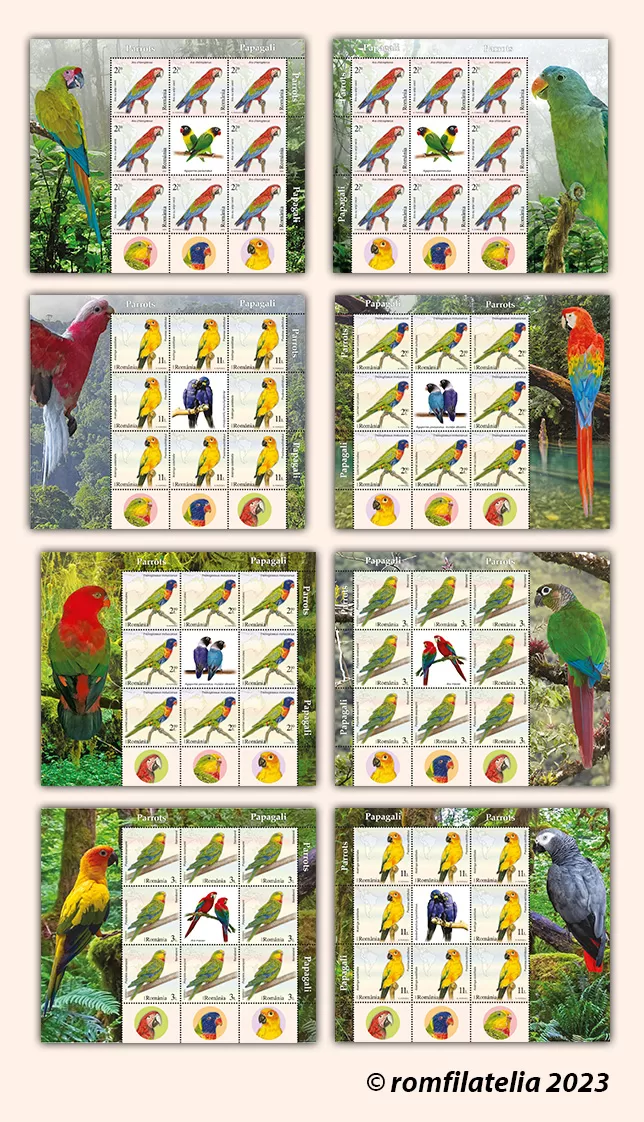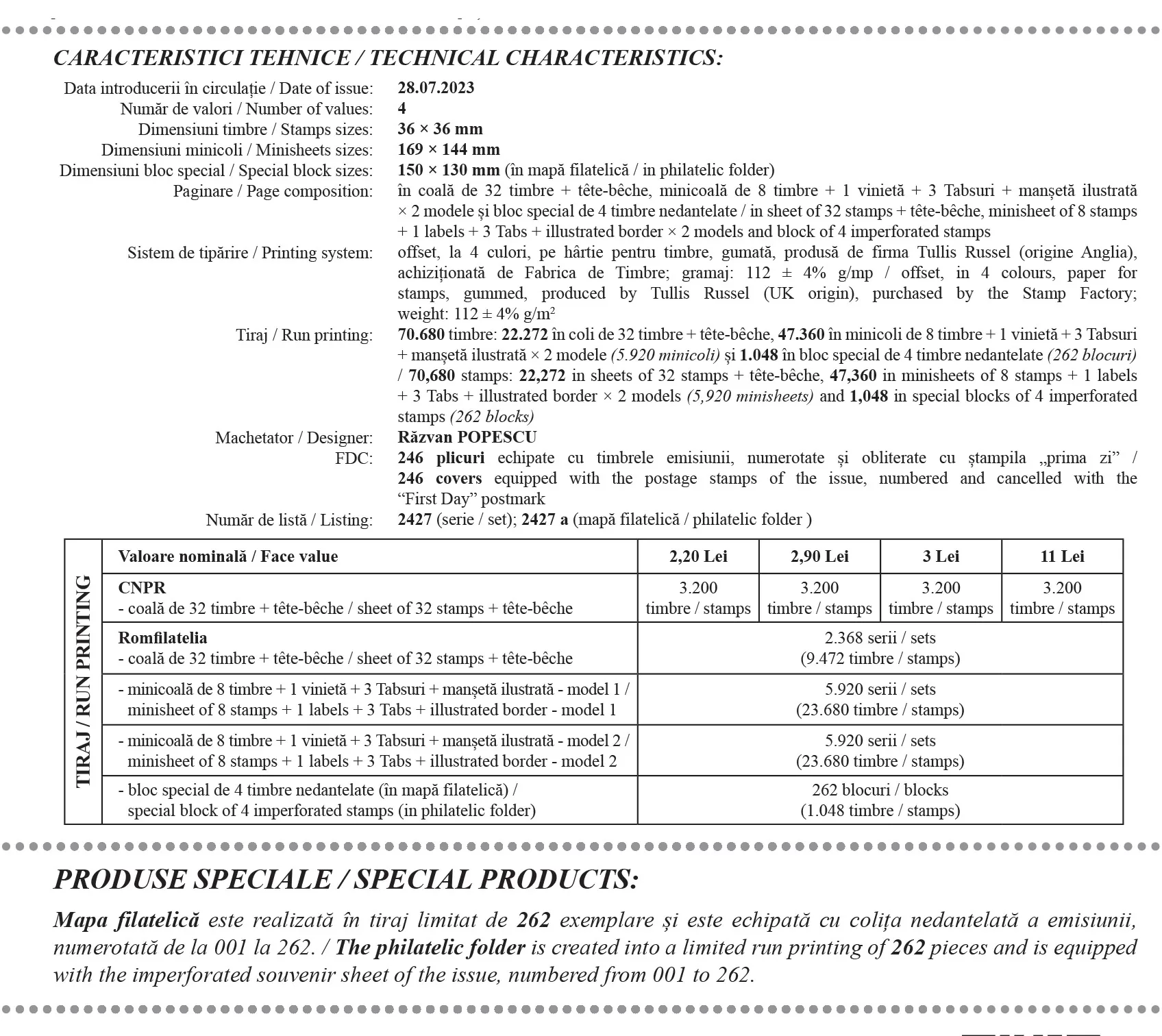 Romfilatelia introduces into circulation on Friday, July 28th, 2023, an interesting issue on the theme of Fauna, entitled “Parrots”, consisting of four postage stamps, a First Day Cover, minisheets designed in two layout versions, as well as a collection philatelic folder.
Romfilatelia introduces into circulation on Friday, July 28th, 2023, an interesting issue on the theme of Fauna, entitled “Parrots”, consisting of four postage stamps, a First Day Cover, minisheets designed in two layout versions, as well as a collection philatelic folder.
Parrots (order Psittaciformes) constitute a very large order of birds with homogeneous characters, including three actual families: the family Strigopidae (owl parrots) comprising three species in two genera; the family Cacatuidae with 21 species grouped in seven genera; and the family Psittacidae with 389 species in 80 genera. It is a systematically well-defined order, being one of the most evolved and specialised of birds. They are characterised by a strong, curved beak as in raptors but with the peculiarity that its upper part is much more developed and not rigidly articulated to the skull bones, birds can raise and lower it. Parrots generally have a very varied coloured plumage and there is often obvious colour dimorphism between the two sexes. They are monogamous birds that generally nest in hollows, rock cavities and rarely on the ground. The young are nestlings. Range is limited to two major dispersal centres, one being the Amazon basin of South America and the islands of Oceania. Most species are arboreal but there are also predominantly terrestrial species.
The red-and-green macaw (Ara chloropterus), depicted on the postage stamp with the face value of Lei 2.20, is the reddest parrot of the “Macaw” group and the largest parrot of the genus Ara. The red-and-green macaw live in a vast area bordered to the North by the Zone Canal in Panama, southern Venezuela, Guyana, Surinam and French Guiana, to the East by the Brazilian provinces of Parana and Mato Grosso, to the South by northern Paraguay, the Argentine province of Formosa and south-eastern Bolivia, and to the West by north-eastern Bolivia, eastern Peru to the Gulf of Cupica in western Colombia. It lives in the tropics at low altitudes near the jungle, but specimens can also be found in the savannah, occurring at the edge of low tropical rainforests up to altitudes of 450 m. Sporadically, specimens have also been found at altitudes of 1400 m, in subtropical areas and dry forests.
The rainbow lorikeet or multicoloured parrot (Trichoglossus moluccanus) depicted on the postage stamp with the face value of Lei 2.90, it is a species of parrot found in Australia. It is common along the East coast from northern Queensland to South Australia. Its habitat is rainforest, coastal scrub and woodlands. It is a medium-sized parrot. On average, they reach about 40 centimetres long from beak to tip of tail feathers. Their slender silhouette is reminiscent of Asian parrots. In conditions of captivity, if well cared for, they can reach a longevity of up to 30 years.
Barraband or Superb Parrot (Polytelis swainsonii) is depicted on the postage stamp with the face value of Lei 3. They are large parrots, reaching up to 40 cm. They are light green parrots with a long tail and a graduated appearance. The adult male has the same light green colour, with a yellow face and well demarcated from the rest of the body by a red band at the base of the neck. They are parrots that belong to the south-eastern part of Australia, from southern New South Wales to the northernmost point of Victoria, they occupy a fairly small area, and breeding occurs only in the southern area below 33° South latitude, where they congregate in large numbers between the Murrumbidgee and Murray rivers, and in the area of the western slopes of the Great Dividing Range.
The sun conure (Aratinga solstitialis), depicted on the postage stamp with the face value of Lei 11, is native to South America (Brazil, Guyana, Venezuela, French Guiana, Surinam), but populations of free-ranging parrots are currently declining due to the burgeoning pet bird trade. The sun conure is distinguished by its slender body and moon tail. The plumage is yellow with orange tints on the forehead, sides of the head, abdomen and back. In fact, the plumage in sunset colours is also responsible for its name: “Sun Aratinga”. The feathers on the underside of the tail are green edged with yellow, and the wings are edged with green and blue. The beak is black and the legs are beige-brown. The eyes are dark brown and the periophthalmic ring is a whitish-gray color. The sun conure reaches lengths of 30 cm, weights 100-120g and lives about 20-30 years.
Romfilatelia thanks the representatives of the “Grigore Antipa” National Museum of Natural History and the Institute of Biology Bucharest within the Romanian Academy for their collaboration to the achievement of this postage stamps issue.



